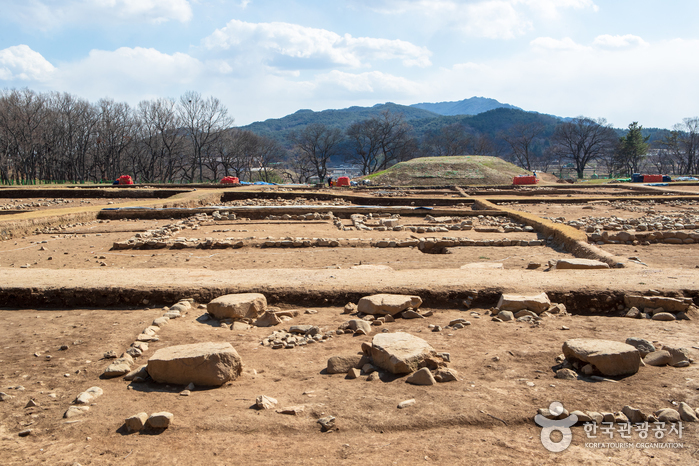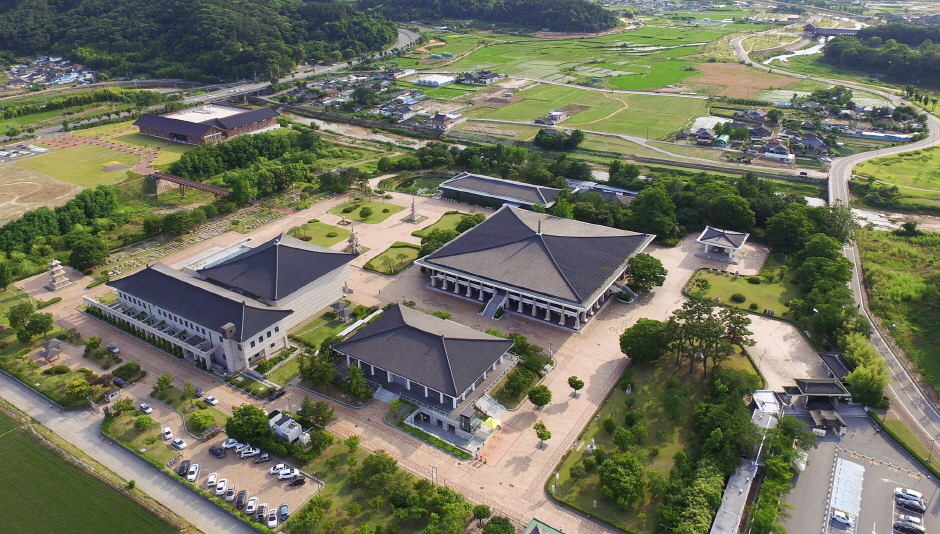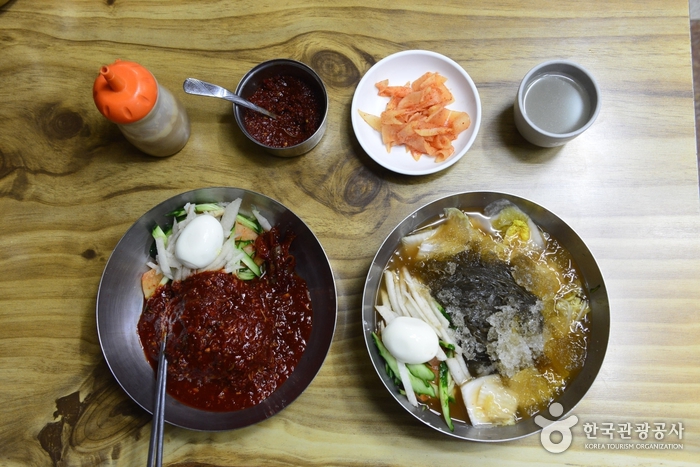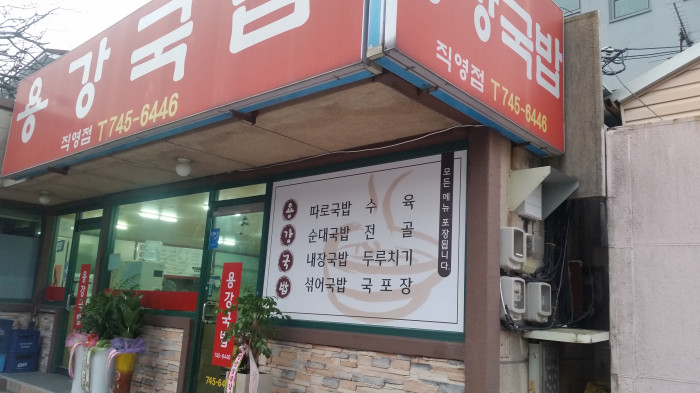ALLEY HOSTEL & GUESTHOUSE [Korea Quality] / 앨리게스트하우스 [한국관광 품질인증/Korea Quality]
5.7 Km 6 2021-03-29
12, Gyerim-ro 106beon-gil, Gyeongju-si, Gyeongsangbuk-do
ALLEY, a guesthouse located in the center of Gyeongju , is located only 3 min by foot from Gyeongju Station. Its supreme accessibility makes it a popular accommodation for backpackers in Gyeongju. There are no parking lots on the promise, but guests renting family rooms have access to parking services.
The first floor of the guesthouse has a lobby, common kitchen, luggage storage, and laundromat. The kitchen offers self-service complimentary breakfast. Visitors can make their own toasts and fried eggs to have with coffee and beverages. The second and third floors house guest rooms. The rooms available include single-occupancy rooms, double-occupancy rooms with single beds, double-occupancy rooms with bunk beds, triple-occupancy rooms with bunk beds, 4-person family rooms with bunk beds, and 4-person dormitory rooms with bunk beds. The family room supports up to five guests. All rooms are equipped with air conditioning and door locks, and have restrooms with shower facilities. Amenities include towels, soap, shampoo, hair conditioner, toothpaste, and hair dryer. Guests also have access to the third floor’s open-air terrace, and may store their luggage there even before their check-in. Daereungwon Ancient Tomb Complex lies about 10 min from the guesthouse, while Cheomseongdae Observatory and Donggung Palace and Wolji Pond can be found 20 min away.
Solar del Palacio Wolseong de Gyeongju (경주 월성(반월성))
5.7 Km 16237 2023-01-16
Inwang-dong, Gyeongju-si, Gyeongsangbuk-do.
Este fue el lugar de la fortaleza del palacio durante la dinastía Silla (57 a.C. - 935). El nombre de la fortaleza significa literalmente 'luna creciente encima del monte'.
Los famosos libros de Samgukyusa dicen que el cuarto rey de Silla, Seoktalhae (57 a 80) pensaba que esta área era ideal para la fortaleza y compró la tierra a un noble. El segundo rey Namhae (4 a 24), impresionado por la acción de Seoktalhae, lo acogió como hijo más tarde, convirtiéndolo en el cuarto rey. La zona estuvo entonces bajo mandato de Silla por 900 años, siendo el último rey, Gyeongsun (927 a 935). A pesar de la magnífica grandeza del palacio, ahora es solo un terreno baldío, y según dicen estaba llena de edificios imperiales de la dinastía Silla.
En la actualidad, la zona de Wolseong tiene un congelador hecho de rocas llamado Seokbinggo, un lugar para arquería, un campo de carreras de caballo y un parque infantil, que se asemeja a los terrenos del período Joseon (la dinastía que gobernó en la península coreana desde 1392 a 1910).
Hwarang Guesthouse [Korea Quality] / 화랑게스트하우스[한국관광 품질인증]
5.7 Km 694 2023-04-13
136-1, Wonhyo-ro, Gyeongju-si, Gyeongsangbuk-do
+82-10-2473-8329
Hwarang Hostel is located near Daereungwon in Gyeongju.
The three-story guest house has ten rooms in all, and there are two types of rooms - double and quad. Every room is equipped with exclusive toilet and bathroom for the user’s convenience.
The atmosphere of the lobby on the first floor is very relaxing and cozy, furnished with various kinds of books including travel guides.
Communal PC and fax, refrigerator, and washing facility are available. Daereungwon ancient tombs, Cheomseongdae observatory, and Donggung & Wolji palace site are within walking distance from the guest house.
Hwarang Hostel boasts of the best location considering the transportation and tourist destinations. You can also rent a bike for 7,000 won a day.
Museo Nacional de Gyeongju (국립경주박물관)
5.7 Km 8950 2023-01-16
Iljeong-ro 186, Gyeongju-si, Gyeongsangbuk-do.
El Museo Nacional de Gyeongju se caracteriza por su profunda tradición, con una historia de aproximadamente 90 años. Representando a Gyeongju, ciudad que había sido la capital del reino de Silla (57 a.C. - 935 d.C.), es en este museo donde podrá ver la historia cultural de Gyeongju.
El área de exhibición está dividida en cuatro grandes secciones: la Sala Principal, los Anexos I y II, y al aire libre, se halla el Área Descubierta de Exhibición (Predio del Museo). En la Sala Principal, podrá observar cerámicas de barro, y las salas de Artes y Artesanías podrá ver numerosas obras artísticas y trabajos artesanales. La Sala Memorial Gugeun tiene en exhibición 666 reliquias que fueron donadas por Lee Yang-Seon de su colección personal para su preservación. Los restos de reliquias excavadas de las grandes tumbas que se hallaban en la ciudad de Gyeongju se encuentran exhibidas en el Anexo I, o la Galería Gobun. Entre ellos, hay adornos magníficos tales como coronas de oro, coronas ornamentales, cintos y aretes, entre otros. A través de estos artículos podrá vivir la experiencia del sobresaliente nivel artístico del período de Silla. Aproximadamente 30.000 artículos fueron excavados del estanque Wolji, entre los cuales los más significativos se hallan expuestos al público en el Anexo II, o la Galería Wolji. Las demás galerías tienen en exhibición los utensilios del hogar. La gran variedad de clases de ítems ilustra la vida de la corte real durante el período de Silla.
Después de recorrer las galerías, podrá trasladarse al Área Descubierta de Exhibiciones, que la componen los Jardines del Museo. La Campana del Rey Seongdeok colocada aquí es la campana de mayor renombre de los templos budistas. También hay varios artículos de los palacios de la realeza y templos que se hallan exhibidos aquí. Las esculturas budistas decoran la mayoría de los objetos de piedra. Si usted es un viajero interesado en el budismo o la magnificencia de la cultura de los palacios reales, este es un sitio que no deseará perderse.
Nadul Hanok [Korea Quality] / 나들한옥 [한국관광 품질인증]
5.9 Km 261 2020-09-09
4-1, Jjoksaem-gil, Gyeongju-si, Gyeongsangbuk-do
+82-54-777-7738
Nadeul Hanok was opened in 2018 with brand-new facilities, in a location just a minute’s walk from Cheomseongdae Observatory in Gyeongju. You can feel a sense of healing in nature in the traditional style house, built in environment-friendly construction method with wood and earth. The ‘ㄷ’-shaped building creates a snug atmosphere and the hipped-and-gable roof and the curves of the roof tile show the traditional quiet and still flavor of a traditional Korean house. There are 7 rooms in Nadeul Hanok. Among them, the Garam, Gayeon, and Nuri Rooms are offered at 50,000 won for 2 persons during off-season so that visitors can enjoy staying in a traditional Korean house at more affordable prices. All rooms are equipped with a bathroom for better convenience and there is an individual thermostat all year round. Complimentary breakfast made of healthy convenience food is offered to all guests. The menu is composed of barley bread, fruit, coffee, juice, boiled egg, and biscuit, and is subject to change according to situation. What is good is that the breakfast can be delivered to the room if the delivery time is requested during breakfast time, which is from 8 to 9 AM.
It is possible to look around the tourist attractions near Nadeul Hanok on foot. In addition, there are CVs, fast food shops, bike rental shops, and hanbok rental shops adjacent to Nadeul Hanok, enabling a more convenient and joyful tour.
Centro de Arte de Gyeongju (경주예술의전당)
5.9 Km 28372 2021-03-18
Alcheonbuk-ro 1, Gyeongju-si, Gyeongsangbuk-do
El Centro de Arte de Gyeongju cuenta con 3 escenarios grandes para espectáculos y diferentes espacios para albergar exhibiciones y presentaciones artísticas. Fue abierto el 6 de noviembre de 2010.
Wiyeonjae Hanok Stay [Korea Quality] / 위연재 [한국관광 품질인증/Korea Quality]
5.9 Km 4 2021-03-29
7, Jjoksaem-gil, Gyeongju-si, Gyeongsangbuk-do
This hanok (traditional Korean house) is located very near to Cheomseongdae Observatory. Its location in front of the Gyeongju Historic Areas allows guests to reach major sights in Gyeongju like Daereungwon Ancient Tomb Complex, Donggung Palace and Wolji Pond, and Hwangnidan-gil Street by foot. This hanok symbolizes the historicity of the city of Gyeongju in that during its construction a female skeleton and accessories made out of precious metals were excavated from the site. The accommodation’s name comes from the idiom “Muwijayeon (leaving nature as it is),” combining bamboo and pine trees with green grass, show its dedication to ideals of rest and philosophy.
There are five rooms in total, all ondol (under-the-floor heating system) rooms for two. Korean paper lining the walls and old-fashioned furniture speak to the ideal beauty of hanok. The raised floor space, which is attached to the “Munmu” room, is a great place to enjoy the scenery and take pictures. All rooms have modern bathrooms with shower facilities, and a complimentary breakfast is served in the cafe on site from 8:00 to 9:00 in the morning. The complex has abundant parking spaces for the guests.
Pyeongyang Naengmyeon (평양냉면)
5.9 Km 9638 2017-01-19
109-2, Wonhyo-ro, Gyeongju-si, Gyeongsangbuk-do
+82-54-772-2448
The restaurant of Pyeongyang Naengmyeon has been operated through two generations and thus is very famous in Gyeongju. Its noodles are hand-made from starch of Korea-grown buckwheat and potato and broth is made by deeply boiling beef bones. So, noodles are chewy and broth tastes rich and clean.
Yongganggukbap (용강국밥)
6.0 Km 171 2021-03-20
70, Bonghwang-ro, Gyeongju-si, Gyeongsangbuk-do
+82-54-745-6446
The locals’ favorite restaurant that sells Korean-style soups. The best menu at this restaurant is rice soup. This Korean dishes restaurant is located in Gyeongju-si, Gyeongsangbuk-do.
Observatorio Cheomseongdae de Gyeongju (경주 첨성대)
6.0 Km 11416 2023-01-03
Cheomseong-ro 140-25, Gyeongju-si, Gyeongsangbuk-do.
+82-54-772-3843
Cheomseongdae es el observatorio astronómico más antiguo que existe en Asia. Construido durante el reinado de la reina Seondeok (632-647), fue utilizado para observar las estrellas y pronosticar el tiempo. Esta construcción de piedra es una hermosa combinación de líneas rectas y curvas, y fue designada como Tesoro Nacional nº 31 el 20 de diciembre de 1962. Cheomseongdae fue construido con forma cilíndrica, con piedras de 30 cm de diámetro. Fueron apiladas 362 piedras para hacer 27 niveles. Aproximadamente a 4,16 m de altura desde el pie hay una entrada cuadrada de 1 ㎡ y un lugar para colocar una escalera de mano bajo ella. El interior está repleto con tierra hasta el nivel 12, y los niveles 19, 20, 25 y 26 tienen todos largas rocas aferradas en dos áreas, para formar la letra china “井” (jeong). Mide 9,17 m de altura y la piedra de la base de cada lado mide 5,35 m. El equinoccio primaveral y otoñal, los solsticios de invierno y de verano y los 24 períodos solares (también conocidos como el año solar astronómico) eran determinados por la observación de las estrellas. La letra “jeong” de piedra de la cima del observatorio, se cree que se ha utilizado como estándar para decidir las direcciones: norte, sur, este y oeste. Las 362 piedras utilizadas para construir Cheomseongdae representaban los 362 días del año lunar.
![ALLEY HOSTEL & GUESTHOUSE [Korea Quality] / 앨리게스트하우스 [한국관광 품질인증/Korea Quality]](http://tong.visitkorea.or.kr/cms/resource/80/2707780_image2_1.jpg)


![Nadul Hanok [Korea Quality] / 나들한옥 [한국관광 품질인증]](http://tong.visitkorea.or.kr/cms/resource/86/2636486_image2_1.jpg)

![Wiyeonjae Hanok Stay [Korea Quality] / 위연재 [한국관광 품질인증/Korea Quality]](http://tong.visitkorea.or.kr/cms/resource/51/2708951_image2_1.jpg)


 Español
Español
 한국어
한국어 English
English 日本語
日本語 中文(简体)
中文(简体) Deutsch
Deutsch Français
Français Русский
Русский